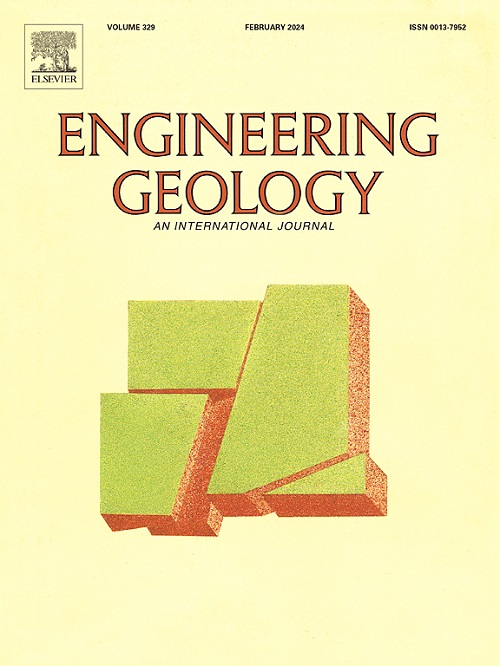Interfacial shearing characteristics between siliceous sand and the various scales of bioinspired scaled suction caisson during penetration
IF 6.9
1区 工程技术
Q1 ENGINEERING, GEOLOGICAL
引用次数: 0
Abstract
Siliceous sand is widely encountered in the Yellow Sea, China, in which offshore wind and photovoltaic farms have been gradually constructed. The suction caisson has been proven to be suitable to support the upper structures due to its easy installation and retrieval. However, the high strength and compactness of the siliceous sand may increase the difficulty in the suction caisson installation. Also, the soil parameters are the key factors in designing the suction caisson. Therefore, this study proposes an innovative scaled suction caisson (SSC), which features easy penetration, high bearing capacity, and elimination of grouting in the gap between the soil plug and the cap. Compared with the traditional suction caisson, a bio-inspired design concept on its outer sidewall mimics the characteristics of snake belly scales to reduce resistance during installation and to increase resistance when being subjected to uplift. Smooth penetration to the design depth is crucial under reasonable arrangement of the scales. Therefore, the arrangement of scales on the outer sidewall in the design of the SSC is examined through a series of direct shear tests. The interface shear behaviors of sand-sand and sand-scaled steel are investigated with various scale types, scale heights, scale aspect ratios, sand grain gradations, and normal stresses. Results show that the sand-sand interface exhibits strain softening. The amount of sand roundness exceeding 0.7 for sizes 0.5–1.0 mm and 1.0–2.0 mm is 67.92 % and 41.55 %, respectively. Under identical sand particle size and normal stress conditions, the interface shear stress at the sand-scaled steel increases first and then decreases with increasing scale height for similar types of scales. Under normal stresses of 200 kPa and 400 kPa, the number of sand particles in 0.5–1.0 mm increases by 7.96 % and 8.29 %, respectively, after shearing for sand size 1.0–2.0 mm with scaled steel plates. In addition, as the scale height increases during shearing, two shear zones are observed: the sand-scaled steel shear zone and the sand-sand shear zone. Meanwhile, the theoretical formulas for calculating the critical shear stress are obtained. Finally, the peak shear stress, stress ratios and sand vertical movement at the sand-scaled steel interface are analyzed, determining the optimal geometric characteristics and arrangement of scales. This study can provide guidance for the construction of foundation structure in marine geological engineering of siliceous sand.
硅质砂与不同尺度的仿生吸力沉箱侵彻过程中的界面剪切特性
硅质砂在中国黄海广泛存在,海上风电和光伏电站已逐步建成。吸式沉箱安装方便、回收方便,适用于支撑上部结构。然而,硅质砂的高强度和致密性增加了吸力沉箱安装的难度。同时,土体参数也是设计吸力沉箱的关键因素。因此,本研究提出了一种新型的规模吸力沉箱(SSC),该沉箱具有穿透性好、承载能力高、无需土塞与井盖间隙注浆的特点。与传统的吸力沉箱相比,其外侧壁采用仿生设计理念,模仿蛇腹鳞的特点,减少安装阻力,增加受拔阻力。在合理布置尺度的情况下,顺利穿透设计深度至关重要。因此,通过一系列的直剪试验,对SSC外侧壁鳞片的布置进行了研究。在不同的尺度类型、尺度高度、尺度长径比、砂粒级配和法向应力条件下,研究了砂-砂和含砂钢的界面剪切行为。结果表明:砂-砂界面呈现应变软化;粒度为0.5 ~ 1.0 mm和1.0 ~ 2.0 mm的砂粒圆度大于0.7的占67.92%和41.55%。在相同的砂粒度和法向应力条件下,相似类型的水垢随着水垢高度的增加,界面剪切应力先增大后减小。在200 kPa和400 kPa的应力作用下,1.0 ~ 2.0 mm的砂粒剪切后,0.5 ~ 1.0 mm的砂粒数分别增加了7.96%和8.29%。此外,随着剪切过程中尺度高度的增加,可观察到两个剪切区:含砂钢剪切区和砂-砂剪切区。同时,给出了计算临界剪应力的理论公式。最后,分析了砂垢钢界面处的峰值剪应力、应力比和砂的垂直运动,确定了砂垢的最佳几何特征和布置方式。该研究可为硅质砂海洋地质工程中基础结构的施工提供指导。
本文章由计算机程序翻译,如有差异,请以英文原文为准。
求助全文
约1分钟内获得全文
求助全文
来源期刊

Engineering Geology
地学-地球科学综合
CiteScore
13.70
自引率
12.20%
发文量
327
审稿时长
5.6 months
期刊介绍:
Engineering Geology, an international interdisciplinary journal, serves as a bridge between earth sciences and engineering, focusing on geological and geotechnical engineering. It welcomes studies with relevance to engineering, environmental concerns, and safety, catering to engineering geologists with backgrounds in geology or civil/mining engineering. Topics include applied geomorphology, structural geology, geophysics, geochemistry, environmental geology, hydrogeology, land use planning, natural hazards, remote sensing, soil and rock mechanics, and applied geotechnical engineering. The journal provides a platform for research at the intersection of geology and engineering disciplines.
 求助内容:
求助内容: 应助结果提醒方式:
应助结果提醒方式:


